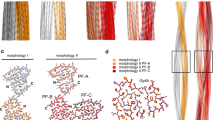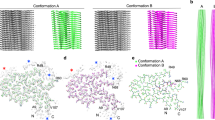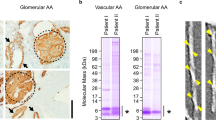Abstract
IT has been shown by Glenner et al.1 that certain amyloid fibrils, chiefly derived from primary amyloidosis or amyloidosis associated with myelomatosis, consist of immunoglobulin chains or their fragments. The principal component of these fibrils seems to be derived from the variable part of monoclonal κ or λ light chains (Bence-Jones proteins). In addition, a “non-immunoglobulin” amyloid fibril protein with a molecular weight of 85,000, named by us protein AS (amyloid subunit), which comprises an essential part of some secondary amyloid fibrils, has been detected by Benditt et al.2 and by other groups3–5. The protein AS is found in secondary amyloid, chiefly associated with chronic inflammations, and has been suggested to be a fragment of a hitherto unknown larger protein4. Except for the detection of some light chain material connected with amyloid fibrils of the “non-immunoglobulin” type6,7, no chemical link between the primary (“light chain”) and secondary (“non-immunoglobulin”) classes of amyloid substances has been established. On the contrary, the question has been raised whether there are two completely different chemical classes of amyloid8.
This is a preview of subscription content, access via your institution
Access options
Subscribe to this journal
Receive 51 print issues and online access
$199.00 per year
only $3.90 per issue
Buy this article
- Purchase on Springer Link
- Instant access to full article PDF
Prices may be subject to local taxes which are calculated during checkout
Similar content being viewed by others
References
Glenner, G. G., Terry, W., Harrada, M., Isersky, C., and Page, C., Science, 172, 1150 (1971).
Benditt, E. P., Eriksen, N., Hermodson, N. A., and Ericsson, L. H., FEBS Lett., 19, 169 (1971).
Ein, D., Kimura, S., and Glenner, G. G., Biochem. biophys. Res. Commun., 46, 498 (1972).
Franklin, E. C., Pras, M., Levin, M., and Frangione, B., FEBS Lett., 22, 131 (1972).
Husby, G., Sletten, K., Michaelsen, T. E., and Natvig, J. B., Nature, 238, 187 (1972).
Levin, M., Franklin, E. C., Frangione, B., and Pras, M., J. clin. Invest., 51, 2773 (1972).
Husby, G., and Natvig, J. B., Clin. expl. Immun., 10, 635 (1972).
Benditt, E. P., and Eriksen, N., Am. J. Path., 65, 231 (1971).
Pras, M., Schubert, M., Zucker-Franklin, D., and Franklin, E. C. J., J. clin. Invest., 47, 924 (1968).
Husby, G., Sletten, K., Michaelsen, T. E., and Natvig, J. B., Scand. J. Immun., 1, 393 (1972).
Author information
Authors and Affiliations
Rights and permissions
About this article
Cite this article
HUSBY, G., NATVIG, J., MICHAELSEN, T. et al. Unique Amyloid Protein Subunit common to Different Types of Amyloid Fibril. Nature 244, 362–364 (1973). https://doi.org/10.1038/244362a0
Received:
Revised:
Issue Date:
DOI: https://doi.org/10.1038/244362a0
This article is cited by
-
Immunocytochemical identification of amyloid in formalin-fixed paraffin sections
Histochemistry (1981)
-
Amyloidosis of the stomach
Virchows Archiv A Pathological Anatomy and Histology (1981)
-
Amyloidosis
La Ricerca in Clinica e in Laboratorio (1974)
Comments
By submitting a comment you agree to abide by our Terms and Community Guidelines. If you find something abusive or that does not comply with our terms or guidelines please flag it as inappropriate.



